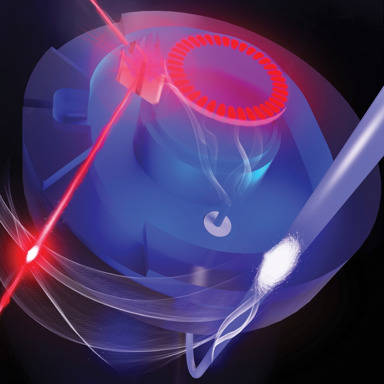 [Enlarge image]An artist’s view of the quantum electro-optical device. [E. Krantz, Krantz NanoArt]
[Enlarge image]An artist’s view of the quantum electro-optical device. [E. Krantz, Krantz NanoArt]
Modern photonic technologies have been harnessed for control of quantum systems ranging from atoms and ions to mesoscopic systems such as mechanical oscillators and collective spins. Quantum measurement and control of microwaves in the electrical domain has facilitated many breakthroughs in emerging quantum technologies, including superconducting quantum computing, quantum simulations and quantum sensing. Emerging hybrid quantum networks, leveraging the full potential of individual quantum systems in both domains, calls for quantum connectivity between optical and microwave fields. This has been hindered so far due to an energy-scale mismatch of greater than 104 and the resulting, mutually imposed loss and noise.
The direct interaction between optical and microwave fields in the quantum regime makes quantum electro-optics particularly interesting.1 It holds great promise for quantum-optical control and sensing of microwave fields, as well as optical quantum networks between superconducting microwave circuits, such as quantum transducers and distributed entanglement.
In recent work, we have coupled a mode-engineered lithium niobate optical resonator to an aluminum superconducting microwave cavity at millikelvin temperatures, allowing for bidirectional microwave–optical conversion in the quantum regime.2,3 This enters a new strong-interaction regime of quantum electro-optics, and enables unprecedented capabilities of quantum-optical control of superconducting microwave circuits. We experimentally demonstrated such control in several studies published this year.
In a first set of experiments, we achieved coherent control of a superconducting microwave cavity using laser light, via electro-optical dynamic back-action.4 The observed coherent microwave and optical response, such as electro-optically induced absorption or transparency, reveals the strong coherent electro-optical interaction and confirms the compatibility between optical light and superconducting microwave circuits.
In additional experiments, we showed quantum entanglement between propagating optical and microwave photons in a millikelvin environment.5 We created and verified the deterministically entangled microwave-optical state in the continuous-variable domain—that is, squeezed by 0.7 dB below the vacuum level. This has established, for the first time we are aware of, a nonclassical communication channel between the disparate worlds of cryogenic superconducting circuits and room-temperature quantum photonics. We believe it paves the way for a wide range of quantum applications, including quantum teleportation and quantum-enhanced sensing.
In our view, these results lay the experimental foundation of quantum electro-optics, and establish a basis for entanglement-based quantum protocols. Being fully compatible with superconducting qubits in a millikelvin environment, our device will facilitate the integration of remote superconducting quantum processors into optical quantum networks using optical quantum channels. In addition, hybrid quantum networks composed of solid-state qubits, atoms and photons at various wavelengths are no longer merely a vision for the future.
Researchers
Liu Qiu, Rishabh Sahu, William Hease, Georg Arnold and Johannes M. Fink, Institute of Science and Technology Austria, Klosterneuburg, Austria
References
1. M. Tsang. Phys. Rev. A 81, 063837 (2010).
2. W. Hease et al. PRX Quantum 1, 020315 (2020).
3. R. Sahu et al. Nat. Commun. 13, 1276 (2022).
4. L. Qiu et al. Nat. Commun. 14, 3784 (2023).
5. R. Sahu et al. Science 380, 718 (2023).
